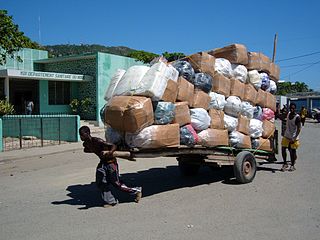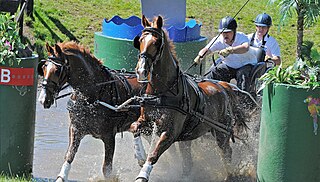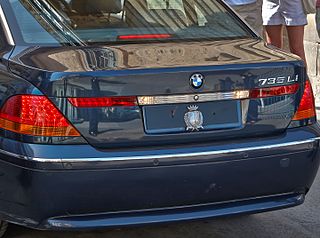
A cart or dray is a vehicle designed for transport, using two wheels and normally pulled by one or a pair of draught animals. A handcart is pulled or pushed by one or more people.

The flag of Malta is a bicolour, with white in the hoist and red in the fly. A representation of the George Cross, awarded to Malta by George VI in 1942, is carried, edged with red, in the canton of the white stripe. The flag was first recognized in the May of 1952.

A carriage is a private four-wheeled vehicle for people and is most commonly horse-drawn. Second-hand private carriages were common public transport, the equivalent of modern cars used as taxis. Carriage suspensions are by leather strapping and, on those made in recent centuries, steel springs. Two-wheeled carriages are informal and usually owner-driven.

A horsecar, horse-drawn tram, horse-drawn streetcar (U.S.), or horse-drawn railway (historical), is an animal-powered tram or streetcar.
A limber is a two-wheeled cart designed to support the trail of an artillery piece, or the stock of a field carriage such as a caisson or traveling forge, allowing it to be towed. The trail is the hinder end of the stock of a gun-carriage, which rests or slides on the ground when the carriage is unlimbered.

A brougham was a light, four-wheeled horse-drawn carriage built in the 19th century. It was named after the politician and jurist Lord Brougham, who had this type of carriage built to his specification by London coachbuilder Robinson & Cook in 1838 or 1839. It had an enclosed body with two doors, like the rear section of a coach; it sat two, sometimes with an extra pair of fold-away seats in the front corners, and with a box seat in front for the driver and a footman or passenger. Unlike a coach, the carriage had a glazed front window, so that the occupants could see forward. The forewheels were capable of turning sharply. A variant, called a brougham-landaulet, had a top collapsible from the rear doors backward.

A runabout is a car body style popular in the 1910s, based on the horse-drawn runabout carriage.

A barouche is a large, open, four-wheeled carriage, both heavy and luxurious, drawn by two horses. It was fashionable throughout the 19th century. Its body provides seats for four passengers, two back-seat passengers vis-à-vis two behind the coachman's high box-seat. A leather roof can be raised to give back-seat passengers some protection from the weather.

Combined driving is an equestrian sport involving carriage driving. In this discipline, the driver sits on a vehicle drawn by a single horse, a pair or a team of four. The sport has three phases: dressage, cross-country marathon and obstacle cone driving — patterned after the mounted equestrian sport of eventing. It is one of the ten international equestrian sport horse disciplines recognized by the Fédération Équestre Internationale (FEI). Combined driving became an FEI discipline in 1970 when Prince Philip, Duke of Edinburgh, the then-president of FEI, produced the first rule book.
A gun carriage is a frame and mount that supports the gun barrel of an artillery piece, allowing it to be maneuvered and fired. These platforms often had wheels so that the artillery pieces could be moved more easily. Gun carriages are also used on ships to facilitate the movement and aiming of large cannons and Guns.These are also used in the funeral procession of any higher authority of any state and country.

Maltese registration plates are the number plates used within Malta to uniquely identify motor vehicles. Since 1995, the three letter, three number system has been in use in Malta for vehicle registration. The characters are always printed in black on a white background, and to the left one can find a blue box with the Flag of Europe and the letter M underneath it in white. The typeface used on Maltese registration plates is FE-Schrift which is also the typeface used on German vehicle registration plates.

A horse-drawn vehicle is a mechanized piece of equipment pulled by one horse or by a team of horses. These vehicles typically had two or four wheels and were used to carry passengers and/or a load. They were once common worldwide, but they have mostly been replaced by automobiles and other forms of self-propelled transport.

The 10.5 cm leFH 18 is a German light howitzer used in World War II and the standard artillery piece of the Wehrmacht, adopted for service in 1935 and used by all divisions and artillery battalions. From 1935 to the end of the war, 11,848 were produced, along with 10,265 of the leFH 18/40 variant.

The Yorkshire Coach Horse is an extinct horse breed once native to England. It was a large, strong, bay or brown horse with dark legs, mane and tail. It was said to be "a longer-legged carriage horse with unmatched ability for a combination of speed, style, and power" and "a tall, elegant carriage horse".

Driving, when applied to horses, ponies, mules, or donkeys, is a broad term for hitching equines to a wagon, carriage, cart, sleigh, or other horse-drawn vehicle by means of a harness and working them in this way. It encompasses a wide range of activities from pleasure driving, to harness racing, to farm work, horse shows, and even international combined driving.

The Rothesay tramway was a narrow gauge electric tramway on the Isle of Bute, Scotland.

The Anglo-Norman horse is a warmblood horse breed developed in Lower Normandy in northern France. A major center of horse breeding, the area had numerous regional types that were bred to one another and then crossed with Thoroughbreds to form the Anglo-Norman. Various body types developed within the Anglo-Norman breed, two of which were split off to form the Norman Cob and French Trotter. The remaining types were eventually standardized, although there remained some criticism of the "hybrid" nature of the breed's conformation. However, it is successful as an international sport horse, especially in the sport of show jumping. The Anglo-Norman also contributed to the development of several other breeds in Europe and Asia.

Bouhagier Patras or Buhayer Patras was considered to be the longest-lived vehicle body manufacturer in Greece. It was founded in 1890 and dissolved in 2004.

The Malta Railway was the only railway line ever on the island of Malta, and it consisted of a single railway line from Valletta to Mdina. It was a single-track line in metre gauge, operating from 1883 to 1931. The railway was known locally in Maltese as il-vapur tal-art.

A stage station or relay station, also known as a staging post, a posting station, or a stage stop, is a place where exhausted horses could be replaced by fresh animals, since a long journey was much faster without delays when horses needed rest. Stage is the space between the places known as stations or stops—known to Europeans as posts or relays.


















